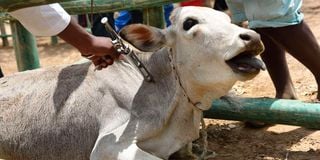Premium
Differentiate these three fatal diseases in your cattle

A veterinary service provider in Kilifi County gives a cow a booster injection. When a farmer finds their animals voiding pellets, she should think of other causes of constipation.
Three diseases keep confusing farmers and even some animal health service providers. Farmers lose animals and production unnecessarily as a result.
The problem is more complicated during the dry season or drought as water scarcity triggers more confusion in the way one of the diseases presents itself.
I recently attended two cases where the farmers were convinced their cows had hard pellet-like dung because of lack of water.
One of the farmers even dismissed an employee when two cows died.
The animal health service provider had diagnosed water deprivation but the poor worker insisted he had given enough water to the cows.
Within the same period, three farmers had called to inquire whether cows could die due to lack of water for a few days.
Their argument was that even if the cows did not get sufficient water, they would still get a significant amount from feed.
The farmers’ argument is scientifically valid and points to the possibility of there being an illness that may be confused with the impact of inadequate water intake in cattle.
The question to consider first then is how a cow deprived of adequate water behaves. That depends on the stage of production of the animal.
Calves develop constipation or hard dung faster than older animals if deprived of water because they take less quantities of succulent feed.
Wet feed
Older animals on wet forage take longer to develop constipation from water deprivation because they get a large quantity from wet feed.
In all cases, cattle deprived of water will visit drinking areas often and even moo.
The animals look at people anxiously and congregate at the drinking place in anticipation that the humans will provide water.
In all cases, the animals look alert and healthy.
Cattle deprived of water will urinate less often in increasingly smaller quantities. The urine progressively changes colour from clear to deep yellow. It also becomes smelly as the animal further dehydrates.
For milking animals, the first signs of poor water intake is sudden and progressive drop in milk yield.
Dung will increasingly harden until it forms into pellets and the animal is not able to void it.
By that stage, the eyes will have started sinking into the socket, the skin tightens on the body and the animal has poor appetite.
Milk production would have stopped but the animal’s eyes will still be bright.
It is unlikely for animals under even moderate care to get to the extreme cases of dehydration where the dung hardens into pellets. When a farmer finds their animals voiding pellets, he or she should think of other causes of the constipation.
The only disease we know that causes severe constipation in cattle is anaplasmosis or gull sickness. It is caused by a blood parasite of the anaplasma species. It is spread by ticks.
An infected animal starts by losing appetite. It then becomes dull and walks lazily.
The stomach stops moving and the cow develops constipation. Dung of an animal with gull sickness is normally hard, covered with a mucus layer and sometimes with blood.
The dung may be yellow due to the production of excessive bile.
Excessive bile is produced when parasite-infected red blood cells are captured and destroyed in the liver.
Yellow mucous
Animals with advanced gull sickness have yellow mucous membranes of the eye, gum and vulva because excess bile enters the blood and is distributed through out the body.
The animal also shows whiteness of the mucous membranes because the blood is being destroyed at a higher rate than it is replaced.
The animal looks dull, sick and does not eat or drink. Most infected cows die if not treated appropriately.
All the cases I was consulted for had gull sickness and not water deprivation.
For safety, farmers should consider all animals with constipation to be having gull sickness until diagnosed differently by a health service provider.
The other two diseases that occur concurrently with gull sickness are red water and east coast fever.
The two are also caused by blood parasites that infect the red blood cells and are spread by ticks.
Red water is also called babesiosis, caused by babesia parasites. It is more dramatic than gull sickness and kills faster if untreated.
Unlike gull sickness causes the animal to void red urine, hence the name red water.
Infected cells burst when the parasites mature. This releases haemoglobin that gives red blood cells their colour. The haemoglobin is filtered in the kidneys and voided in urine.
East coast fever is the most dramatic of the three tick-borne diseases. It causes sudden drop in appetite and milk yield.
Body temperature suddenly rises to above 40.5 degrees Celsius. The animal actually feels hot on touch.
The animal discharges saliva and tears and has difficult breathing. Eyelids droop and the animal avoids sunlight. The lymph nodes under the skin are swollen and clearly visible.
If diagnosed early, the three diseases are curable. They are also preventable when animals are washed with acaricides once or twice per week, depending on the level of tick challenge in an area.
East coast fever can also be prevented through a special form of vaccination called infection and treatment.
Because of its mild nature and slow progression, anaplasmosis is often missed by farmers and many animal health service providers.
Keen examination and follow up should be done for animals with any or a combination of the three tick borne diseases for about three weeks from the onset of sickness.





